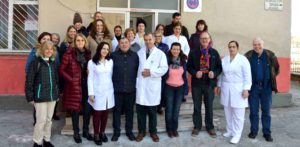EUscreen
The Infant Vision Lab’s expertise with photorefraction in 2016 to Anna Horwood being invited to be a co-applicant on the multi-million Euro EU Horizon 2020 EUSCREEN project.
This was a multi-centre collaboration looking at vision and hearing screening in children internationally. It ran from 2017 to 2021 and was led by Professor Huib Simonsz from the Erasmus Medical Centre in Rotterdam. There were major partners from the UK (Sheffield and Reading), The Netherlands, Sweden, Germany, Albania and Romania, as well as contributing Country Representatives from over 50 countries worldwide, but mainly in Europe.
Click here for a copy of the report from our Final Conference with a resume of the outcomes

Visiting a maternity hospital in rural Albania 2017
The project was set up to establish the most cost-effective way of screening children for vision and hearing defects, following four main strands of work
- A massive survey of how screening is done across over 45 different countries, mainly in Europe with Country Reports for each country. The main conclusion here was that there is little consensus, and a huge amount of variability, in who screens, how often, using which test. Although screening services are common and acceptable, every country does it differently and they are often set up and run with very little audit, reporting or use of evidence. Reading’s contribution to this was a study on the effectiveness of photoscreening.
- An interactive computer Cost-Effectiveness Model, designed using the best available evidence. Anybody planning starting or changing a screening service can enter different variables e.g. age at screening, available personnel and their costs, to test different scenarios to find the most cost-effective.
- To complement the Model, we also ran two Implementation Studies, setting up new screening services for hearing in Albania and vision in Romania, so that we could study the challenges, barriers and their solutions encountered along the way
- Finally we wrote a comprehensive Manual for anyone planning or modifying their screening. The manual is full of practical advice and tips to complement the Model.
The main outcomes of the study were
- Data monitoring and audit need to be much better and planned from the outset
- Countries need to share their results so that there can be more consensus and evidence-based decisions
- The most cost effective form of vision screening in children beyond the immediate neonatal period is a single, accurate visual acuity test at 4-5 years -very similar to the current UK system.
- A paper published in 2023 looks at long-term treatment costs, which are rarely considered. Total cost from screening to final discharge increase dramatically the more treatment visits a child needs, especially if treated by expensive professionals. Although early treatment of amblyopia is ideal, on a population level (looking for the best outcomes for the largest proportion of the population), it may more cost-effective to screen WELL but a bit later so more children can access affordable treatment.

